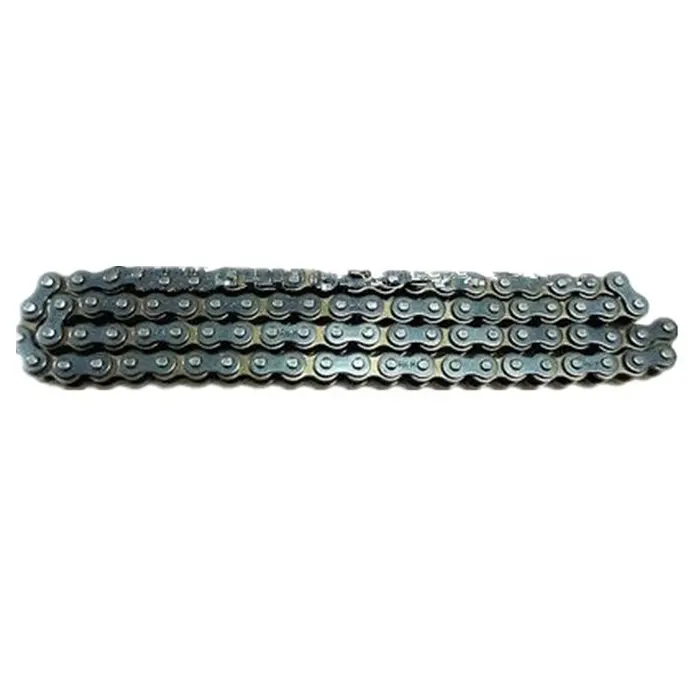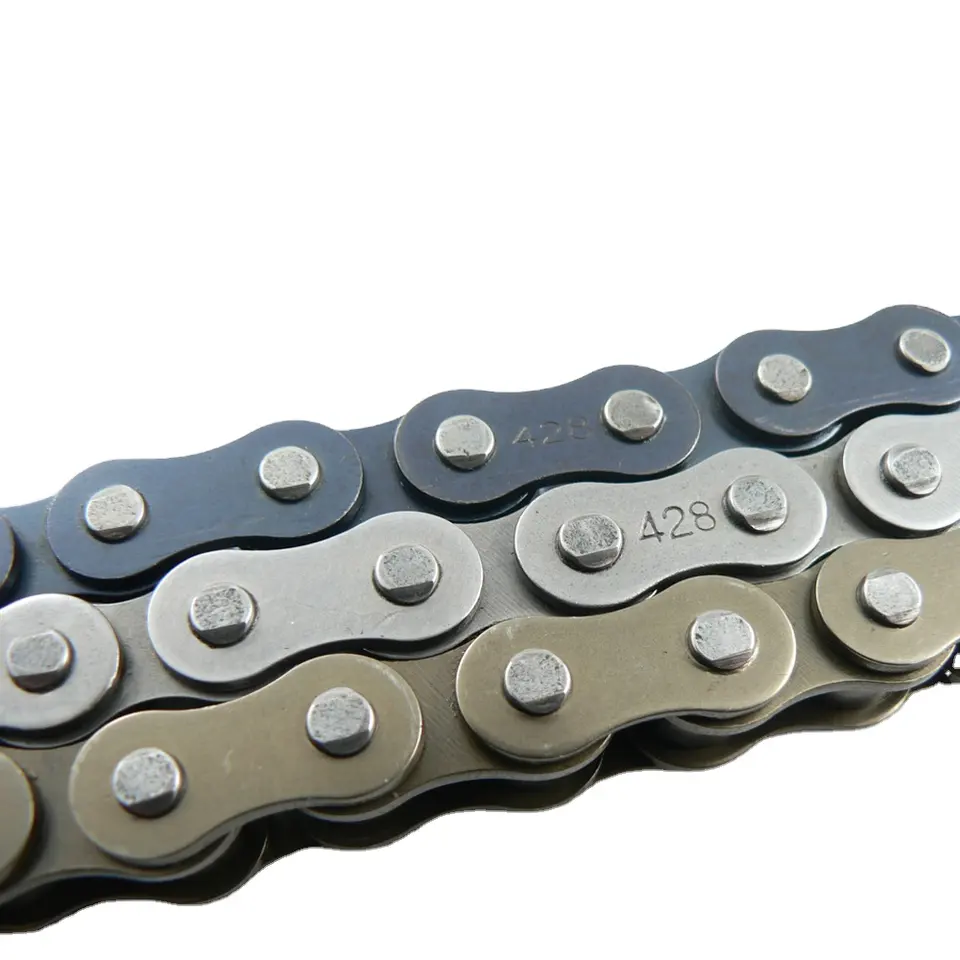Product Description
1. Standare conveyor roller chain available models: 1.08A2.10A3.12A4.16A5.20A6.24A7.28A8.32A9.06B10.08B11.10B12.12B13.16B
2. Escalator Step Chains, Escalator Drive Chain: T67 – 24S
3. Trencher Chains (Digging Chains): 015H – TR2690
4. Asphalt Paving Chains, Paving Machine Chain: SS40L – RMC15128
5. Flow Conveyor Chains: DK4011S – DK160H250M
6. Tobacco Industry Machinery Chains
Roller chain material we use:
Plate: 40Mn, 45Mn steel
Pin: 30CrMnti or 40Cr
Bush: We use 10# or 20Mn
Roller: 10#, 20# or 35# steel
Chain size:
Standard chain:
35-1, 40-1, 50-1, 60-1, 80-1, 100-1, 120-1, 140-1, 160-1, 200-1, 240-1
35-2, 40-2, 50-2, 60-2, 80-2, 100-2, 120-2, 140-2, 160-2, 200-2, 240-2
06B-1, 08B-1, 10B-1, 12B-1, 16B-1, 20B-1, 24B-1, 28B-1, 32B-1, 40B-1, 48B-1, 56B-1, 64B-1, 72B-1
06b-2, 08B-2, 10B-2, 12B-2, 16B-2, 20B-2, 24B-2, 28B-2, 32B-2, 40B-2, 48B-2, 56B-2, 64B-2, 72B-2
C2040, C2042, C2050, C2052, C2060, C2062, C2080, C2082, C2100, C2102, C2120, C2122, C2160, C2162 and so on.
Nonstandard chain:
We can do all kinds of nonstandard chains as per your request
Applications:
Roller chains work with sprocket together to drive on industrial machine, automobile, motorcycle, agriculture machine and so on
| Material | Stainless steel, alloy steel |
| Process | Assembled |
| Heat treatment | Case hardening, Meshbeltfurnace quenching heat treatment |
| Surface treatment | Blacking, galvanization, chroming, electrophoresis, color painting, or customer requirement |
| Performance | High precision, high wear resistance, low noise, smooth and steady, high strength |
| Model number | Standard or nonstandard (single duplex and triple) 35-1, 40-1, 50-1, 60-1, 80-1, 100-1, 120-1, 140-1,160-1,200-1,240-1 35-2, 40-2, 50-2, 60-2, 80-2, 100-2, 120-2, 140-2, 160-2, 200-2, 240-2 06B-1,08B-1,10B-1,12B-1,16B-1,20B-1,24B-1,28B-1,32B-1,40B-1,48B-1,56B-1,64B-1,72B-1 06b-2,08B-2,10B-2,12B-2,16B-2,20B-2,24B-2,28B-2,32B-2,40B-2,48B-2,56B-2,64B-2,72B-2 |
| Packaging | Inner plastic bag and outer carton box or customer requirement. |
| Material: | Carbon Steel |
|---|---|
| Surface Treatment: | Oxygenation |
| Process: | Assemble |
| Installation: | Turning |
| Motor Type: | Frequency Control Motor |
| Surface: | Zinc Plated, Blacken |
| Customization: |
Available
| Customized Request |
|---|

What are the signs of wear and tear in a motor chain?
Over time, a motor chain can experience wear and tear due to usage, environmental factors, and lack of proper maintenance. It’s important to monitor the condition of the motor chain regularly to identify signs of wear and address them promptly. Here are some common signs of wear and tear in a motor chain:
1. Chain elongation: One of the most noticeable signs of wear in a motor chain is elongation. The chain may appear longer than its original length due to stretching and wear of the pins, bushings, and rollers. Excessive chain elongation can cause poor performance, increased noise, and affect the overall efficiency of the system.
2. Increased chain noise: As a motor chain wears, it can produce more noise during operation. Excessive noise can indicate worn-out or damaged components, such as pins, bushings, or rollers. It’s important to investigate and address the source of the noise to prevent further damage and ensure smooth operation.
3. Chain slack or looseness: If the motor chain exhibits excessive slack or looseness, it may indicate wear and elongation. Proper tension is essential for the efficient transfer of power, and a loose chain can cause slippage and decreased performance.
4. Visible signs of damage: Inspect the motor chain visually for any visible signs of damage, such as broken links, cracked plates, or worn-out pins and bushings. These signs indicate significant wear and may require immediate attention or replacement of the chain.
5. Uneven wear: Uneven wear patterns on the chain’s components, such as unevenly worn pins or bushings, can indicate misalignment or other issues. Identifying and addressing the cause of uneven wear is crucial to prevent further damage and ensure proper chain performance.
Regular inspection and maintenance can help identify these signs of wear and tear in a motor chain. If any of these signs are observed, it is recommended to consult a professional or the chain manufacturer for further evaluation and guidance on appropriate maintenance or replacement.

What are the advantages of using a motor chain in power transmission?
Using a motor chain in power transmission offers several advantages:
1. High Efficiency: Motor chains are designed to transmit power efficiently from the motor to the driven equipment. They minimize energy losses and ensure maximum power transfer, resulting in high overall system efficiency.
2. Reliable Power Transmission: Motor chains provide a reliable means of transmitting power in various applications. They have high load-bearing capabilities and can handle both high torque and high-speed operations, making them suitable for a wide range of industrial processes.
3. Compact Design: Motor chains have a compact design, which allows for efficient power transmission in tight spaces. They can be easily integrated into machinery and equipment without occupying excessive space.
4. Precise Speed Control: Motor chains enable precise speed control of the driven equipment. By selecting the appropriate chain size and gear ratio, you can achieve the desired speed and maintain consistent operation, essential in applications that require precise motion control.
5. Versatility: Motor chains are versatile and can be used in various power transmission systems, including conveyor systems, automotive assembly lines, industrial machinery, and more. They can accommodate different loads, speeds, and operating conditions.
6. Durability and Longevity: Motor chains are designed to withstand heavy-duty applications and harsh operating environments. They are made from high-quality materials, such as alloy steel, that provide excellent strength, wear resistance, and durability, ensuring a long service life.
7. Easy Maintenance: Motor chains typically require minimal maintenance. Regular lubrication and periodic inspection are usually sufficient to keep them in optimal operating condition. This ease of maintenance contributes to the overall cost-effectiveness of using motor chains.
Overall, using a motor chain in power transmission systems offers reliable and efficient power transfer, precise speed control, versatility, and long-term durability. These advantages make motor chains a popular choice in various industries for transmitting power from motors to driven equipment.

How does a motor chain differ from a regular chain?
A motor chain, also known as a power transmission chain, differs from a regular chain in terms of its design and purpose. Here are the key differences:
1. Load Capacity: Motor chains are specifically designed to handle higher loads compared to regular chains. They are built to transmit power and motion between different components in mechanical systems.
2. Precision and Accuracy: Motor chains often have precise tooth profiles or roller systems that ensure accurate positioning and synchronization of components. This is important in applications such as engines, where precise timing is critical.
3. Durability and Strength: Motor chains are built to withstand heavy loads, high speeds, and continuous operation. They are constructed using high-quality materials and advanced manufacturing techniques to ensure durability and strength.
4. Lubrication and Maintenance: Motor chains may require specific lubrication to reduce friction and wear, ensuring smooth operation. Regular maintenance, such as periodic inspection and lubrication, is important to keep the chain in optimal condition.
5. Application-Specific Design: Motor chains are designed for specific applications, such as power transmission in engines, conveyor systems, or lifting equipment. They are engineered to meet the unique requirements of these applications, considering factors such as load capacity, speed, environment, and operational conditions.
It’s important to note that while motor chains are designed for specific applications, they may have similarities with regular chains in terms of basic construction and functionality. However, motor chains are engineered to handle higher loads, provide precise motion transmission, and ensure reliable performance in demanding industrial settings.


editor by CX 2023-08-22